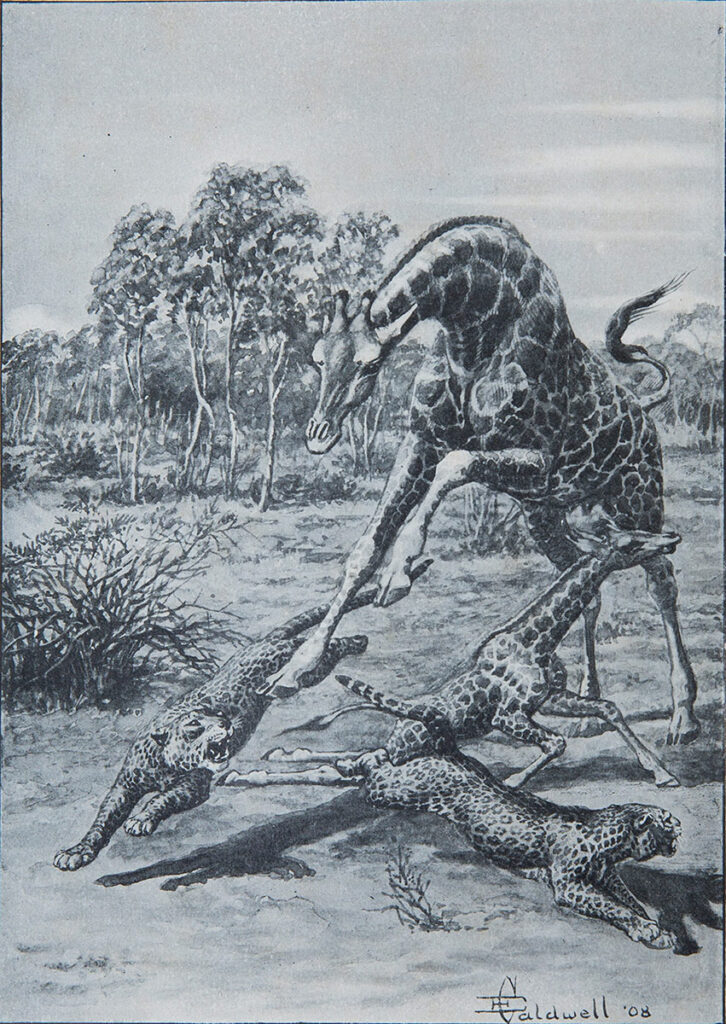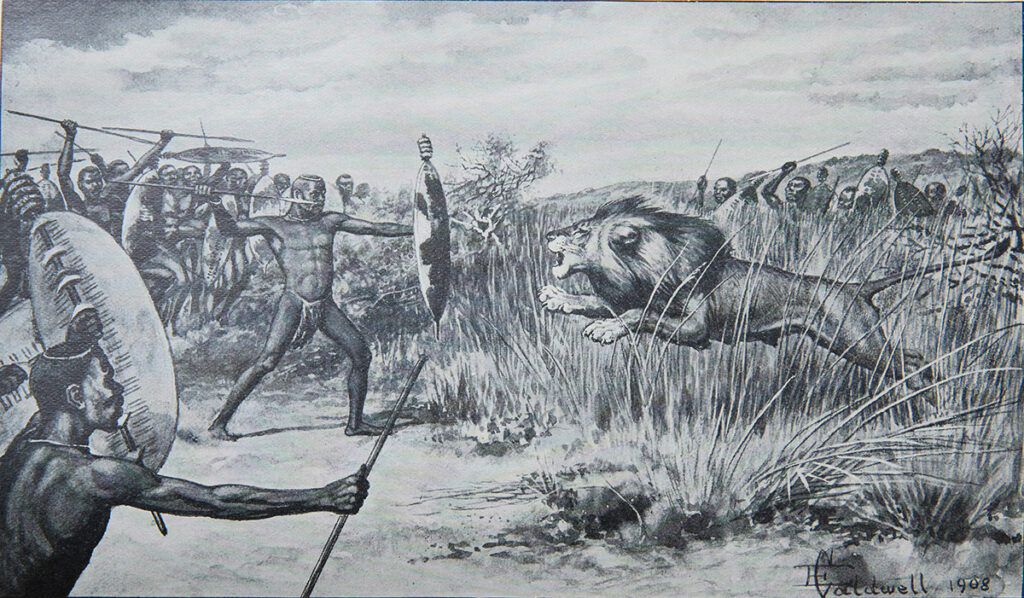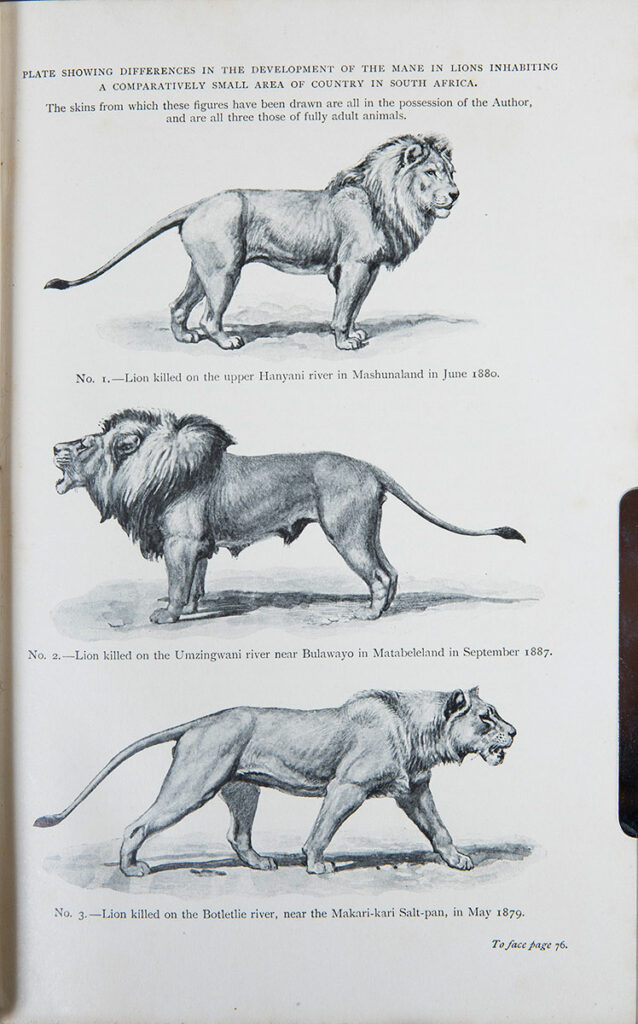Armchair Safari – African Nature Notes and Reminiscences by F.C. Selous
From 1871 to 1891 Selous wandered and hunted over vast areas of South Africa and he saw a vast decrease in game. But in 1891, on behalf of British South Africa Company, he was sent to discover a route free from tse-tse fly between Mashunaland and the East African Coast. Thus he walked into a country teeming with game, an area where no white man before had ever hunted. Elephants still wandered here as did many other game animals, including buffaloes that hardly moved as he walked past them. A few even came trotting towards him. But, in a country so well stocked with antelopes, carnivorous animals were not wanting. Indeed lions were plentiful in this area of the lower Pungwe River at the time when Mr. Rhodes’s pioneers first entered Mashunaland.

But all carnivorous animals are almost entirely nocturnal in their habits, and therefore only occasionally encountered in the daytime. So, on my first visit to this country I saw no lions, nor leopards, no hyenas. But on my second visit a year later, when hunting between the Pungwe River and Lake Sungwe in 1892, I saw only three lions, although there was not a single night when I did not hear some of them roaring. Sometimes they were close to camp; other times they were in the distance. I would take my 31st and last lion on this trip.
On the day when I saw three lions, I had left camp with a few native followers very early in the morning and was stalking across an open plain studded with large ant-heaps, from which the long grass had been for the most part burnt off. On my right was a small river whose banks were fringed with a thick growth of scrubby bush. My course lay parallel to this river but outside the strip of bush. Suddenly I came in sight of two lions at a distance of 400 or 500-yards out on the open plain. They were advancing towards the river and had been previously hidden from our view by two large ant heaps. These two lions saw us at the same time that we saw them and at once halted and stood watching us.
Telling my native attendants to sit down and remain where they were until my return, I commenced to walk towards the lions, hoping that they would allow me to approach within shooting distance before running off. I knew that these animals, which in many parts of Africa are very shy and wary, had very little fear of man in the Pungwe district at that time. However, before I had advanced 50 paces, both lions turned around and commenced to walk slowly towards a small patch of long yellow grass which had escaped the last grass fire. They walked away from me at a very slow and leisurely pace. One seemed a monster; the other seemed a female or young male with no mane.

I now commenced to run towards them, but had not gone far when a third lion, that had been previously been hidden by a large ant-heap, was suddenly revealed to me. He had evidently been walking over the plain about one hundred yards to the right of the other two lions and not having seen me, did not understand why these latter had first come to a halt and then turned round and walked back again in the direction from which they had just come. When I first saw the third lion he was standing turned away from me and looking at the other two.
Quickly swerving to the left but without stopping, I almost immediately put a large ant-heap between us and then ran to it at my utmost speed. This ant-heap was quite 20-feet in diameter at the base and 10 or 12-feet in height. I quickly climbed halfway up the heap and then looked around the side and saw that the single lion was still standing watching the other two, which were at that moment just entering the patch of long grass of which I have already spoken.
I now edged myself in a sitting position to the side of the ant-heap nearest the lion and prepared for a shot. He was facing half away from me and a bit more than 200-yards off. But there was not so much as a blade of grass in the shape of cover on the level burnt plain between us, and had I attempted to get nearer to him he would have trotted off after his companions. So, steadying myself and taking careful aim with the 200-yard sight, I fired. My bullet must have passed close beneath the lion’s chest – I think behind his forelegs – as I saw it knock up the dust just beyond him. He at once sprang to the spot where the bullet struck the ground and again stood still, facing now exactly away from me, without apparently having taken any notice of the report of my rifle – a .450 bore singled-barreled Gibbs-Metford.
Extracting the empty cartridge and pushing a fresh one into the breech, as silently and quickly as possible, I fired again this time taking a fuller sight and aiming for the center of the lion’s somewhat narrow hind quarters. The dull thud which answered the report of the rifle assured me that I had hit him, but I never before saw a lion make so little fuss about a wound. He gave one spring forwards, accompanied by a loud growl and then stood still again. But only for a moment.
Then he came trotting round towards where I sat on the side of the ant-heap, turning first to one side, then to the other, evidently searching for what had hurt him. I am sure that he had he made me out, he would have charged instantly. However I was dressed only in an old felt hat, a cotton shirt, and a pair of shoes. My scanty garments and bare sunburned limbs were all so weather-stained and harmonized so well with the neutral tints of my immediate surroundings that he never saw me.
I had thrown the empty cartridge out of my rifle before the lion turned, but had no time to reload before he commenced to trot towards me. Knowing that the very slightest movement on my part would attract his attention, I sat perfectly still, feeling sure that in case of a charge I should have ample time to slip the cartridge, which I held ready in my hand, into the breech of the rifle before he got to me. However, he never discovered me, though he approached to within 100 yards of the ant-heap on the side of which I was sitting. He then stopped and after first looking towards me, turned round once more and stood facing exactly away from me.
This was my chance, so hastily loading and putting down the 200-yards’ leaf sight, I again fired at him and again heard my bullet strike. With a loud growl he sprang forwards and then went off at a gallop. He turned almost immediately and, running almost broadside to me, made for a large ant-heap with some bushes growing at the top of it. Before he reached it I fired again and knocked him down, but after having lain still for a few moments he got up and half-ran, half-dragged himself to the ant-heap and disappeared behind the bush on its summit.
I now walked round and reconnoitered the ant-heap behind which the lion had disappeared and found that just beyond it there was a small patched of unburned grass, quite six feet high, in which, no doubt, he was hiding. To have approached this patch of long grass across the open plain would, I felt, sure, have meant facing a fierce charge at close quarters, for the wounded lion had shown every sign of being a savage and determined animal.

About 200 yards to the left of the place where the lion was lying was another ant-heap, at the foot of which grew two good sized trees. And as I thought I might be able to see something from the top of one of them, I went back to where I had left my Kaffirs. Taking one of them with me, I made a circuit and came up behind the trees. My native attendant quickly climbed up to the top of one of them but declared he could see nothing of the lion, although he said that the patch of grass in which it was lying was very small. He then began to come down the tree again, talking all the time.
He had got about half way down when two warthogs, which had been lying asleep somewhere near us, disturbed by his voice, got up and started trotting straight towards the spot where the lion was lying. They did not enter the grass but passed close to it, and the lion must have heard them coming and made ready at once to repel another attack, for the Kaffir suddenly saw it standing just within the edge of the grass. “Sir, I can see the lion,” he called to me in his own language.
“I can see nothing,” I answered.
“Come up the tree a little way he said,” and you will be able to see it. I told him to come down low enough to reach the rifle I handed to him, and then I climbed into the lower branches of the tree. When about 10 feet above the ground, I could see the lion’s head. I also saw the outline of its back distinctly through the grass. First aroused by the near approach of the warthogs, the lion was no doubt listening to us talking.
I got a little higher up the tree, but although from this position I commanded a somewhat clearer view, I could not steady myself to fire, so I came lower down and fired a shot with the 200-yards sight. This shot missed the lion altogether. But it had an excellent effect, as the angry brute at once charged out of the grass and came straight towards where he had heard the talking. At first he showed signs of partial paralysis in the hind-quarters, but gathering strength with every stride he was soon coming along at a great pace, growling savagely and evidently prepared to make things uncomfortable for the first human being he met. I let him come on to within about 50 yards of the tree in which I was perched and then shot him right in the chest with an expanding bullet, which tore open his heart and killed him almost immediately.
This was the last of the 31 lions that I shot in Africa and the only one of those animals that I ever shot from a tree. He was a fine full grown animal, just in his prime with a good mane for a coast lion, very thick set and heavy in build and enormously fat. My first two bullets struck him close together just below the tail, and either would probably have killed him had it been a solid projectile. But being expanding bullets they had probably not penetrated beyond the stomach.
We found subsequently, on examining the place where he had been lying in the grass at the foot of the anthill, that he had vomited great lumps of the meat and skin of a wildebeest on which he had been feasting the previous night. My third bullet had struck him too far back, behind the kidneys and passing just below the backbone, had momentarily paralysed his hindquarters causing him to fall when hit and subsequently to show weakness in the hind legs.
I now had to return to camp, prepare the trophy and then assemble a rather large party for a trip into the Bushman country.–Selected and Edited by Ellen Enzler-Herring of Trophy Room Books

